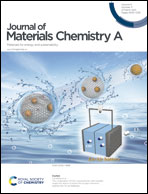Binary non-fullerene-based polymer solar cells with a 430 nm thick active layer showing 15.39% efficiency and 73.38% fill factor†
Abstract
Thickness-sensitive fill factor (FF) is usually encountered by organic active layers with a thickness of several hundred nanometers, which significantly deteriorate the photovoltaic performance of thick-film polymer solar cells (PSCs). Here, paring of high-hole mobility (μh) polymer donor Si25 with benzotriazole-fused Y-series non-fullerene acceptor Y14 is proposed to overcome this challenge. Relative to the electron mobility (μe) of 8.17 × 10−4 cm2 V−1 s−1 for the Y14 pristine film, much higher μe values up to 3.79 × 10−3 cm2 V−1 s−1 were demonstrated using Si25:Y14 binary blend films, achieving μh/μe of 2.31–3.56. The Si25-induced closer packing of Y14 molecules was observed with the blend film. The high and fairly balanced charge transport-enabled PSCs with 320–600 nm thick active layers to show a low FF decay from 74.69% to 67.46%. Power conversion efficiencies (PCEs) of 15.39% and 15.03% were achieved for 430 nm and 600 nm thick active layers, respectively. The device performances can supply a wide processing window with high efficiency. Delightedly, green solvent o-xylene cast active layers of 400 nm and 530 nm thickness exhibited PCEs of 14.43% and 14.25%, respectively. This study indicates that high μh polymers and benzotriazole-fused Y-series non-fullerene acceptors are promising candidates to overcome the thickness sensitivity of FF.



 Please wait while we load your content...
Please wait while we load your content...